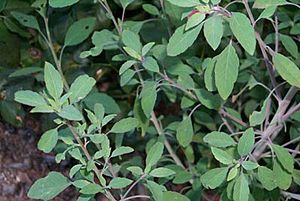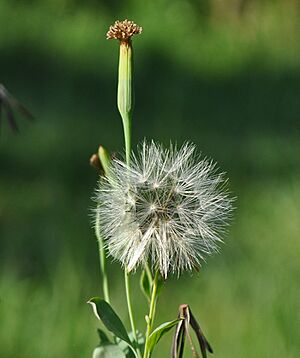Bolivian coriander facts for kids
Quick facts for kids Bolivian coriander |
|
|---|---|
 |
|
| Scientific classification | |
| Kingdom: | |
| (unranked): | |
| (unranked): | |
| (unranked): | |
| Order: | |
| Family: | |
| Tribe: |
Tageteae
|
| Genus: |
Porophyllum
|
| Species: |
P. ruderale
|
| Binomial name | |
| Porophyllum ruderale |
|
Bolivian coriander (Porophyllum ruderale) is a special plant that grows every year. This means it completes its life cycle in one year. Its leaves are often used to add flavor to food. People describe its taste as a mix of arugula, cilantro, and rue.
This plant is very popular in Mexico and South America. There, it is a common ingredient in salsas. When it's fully grown, Bolivian coriander can reach about 5 feet (1.5 meters) tall and 3 feet (0.9 meters) wide.
Contents
What is Papalo?
Bolivian coriander is known by many different names. Some of these names include quillquiña, quirquiña, quilquiña, killi, papalo, tepegua, and pápaloquelite. The name papalo is often used, especially in Mexico.
How People Use Papalo
The fresh leaves of the papalo plant are used to give a unique flavor to many dishes. It's often added to salsas, tacos, and other traditional foods. The strong, fresh taste makes it a favorite herb in many kitchens.
Where Does Papalo Grow?
This plant grows naturally in warm climates. It is especially common in countries like Mexico and many parts of South America. It prefers sunny spots and well-drained soil. People also grow it in their gardens because it's easy to care for.
Papalo: Not Your Average Coriander
Even though it's called "Bolivian coriander," this plant is not actually related to the common coriander (also known as cilantro). They belong to different plant families. Bolivian coriander is part of the Asteraceae family, which also includes sunflowers and daisies. Regular coriander is in the Apiaceae family, like carrots and parsley.
See also
 In Spanish: Cilandro boliviano para niños
In Spanish: Cilandro boliviano para niños


